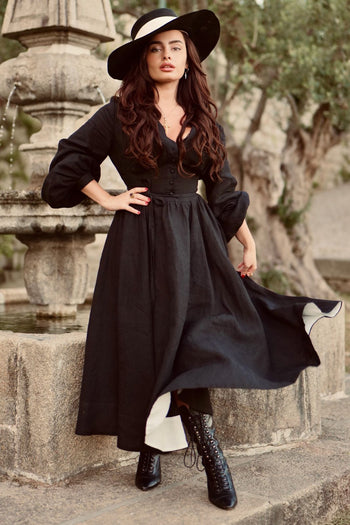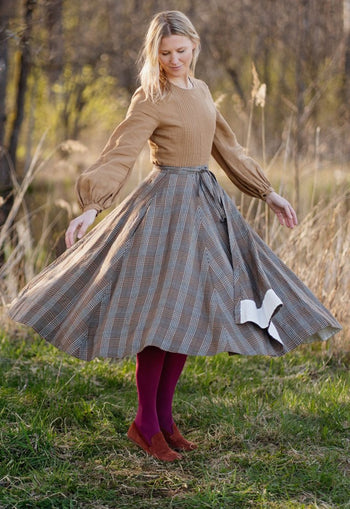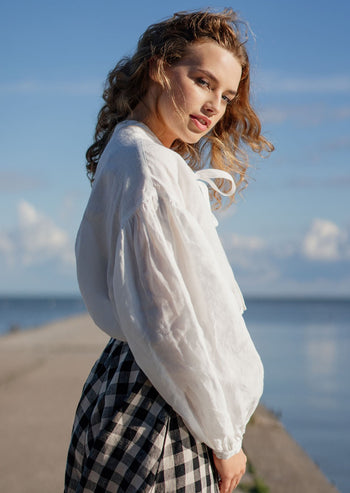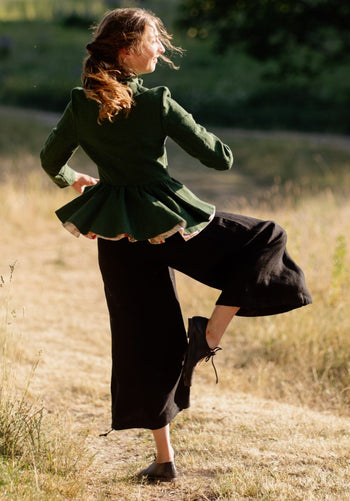How To Dress Vintage? Ideas From Different Eras
In a world where fashion trends come and go like the changing seasons, the timeless charm of dressing vintage continues to captivate hearts.
Whether it's the bold and liberating Flapper Look of the 1920s or Mod style looks of the 1960s, vintage clothes offer a unique opportunity to express personal style while paying homage to the past.
As we explore how to dress vintage, remember, it's not about wearing a vintage piece from head-to-toe; it's about mixing and matching, adding a touch of history to your modern wardrobe, and making sure it doesn't look costumey.

How to Style Vintage Dresses from Different Eras?
Regency Era (1811-1820): The Empire Silhouette

Beginning with the Regency era, where the empire silhouette held a place of honor, captivating the fashion world with its distinctive high waistline that elegantly commences just below the bust.
This hallmark design flows gracefully to the floor, crafted from light and airy fabrics like muslin, embodying elegance and ease. The silhouette's focus on the bustline, paired with a subtle embrace of the natural waist, crafts a figure that is both flattering and timeless.
It's the delicate touches - embroidery, ribbons, and intricately designed empire bodices - that imbue these gowns with an ethereal quality, elevating them to icons of sophistication and femininity.
How You Can Wear It for a Contemporary Look?
To wear a vintage empire silhouette dress today without looking like you've stepped out of a costume drama requires a thoughtful mix-and-match approach.
Start by choosing a dress in a modern fabric like linen or a contemporary pattern that still nods to the Regency style. To keep it grounded in the 21st century, pair your empire-waist dress with sleek, minimal accessories.
A pair of strappy sandals or ankle boots can lend a modern edge, while a simple leather clutch or a minimalist piece of jewelry will complement the dress's inherent elegance.
For a casual twist, consider layering a tailored blazer or short jacket over your shoulders. This not only adds structure but also creates an intriguing blend of historical and contemporary fashion.
Romantic Era (1820-1830s): The Hourglass Silhouette

Transitioning from the simplicity of the empire silhouette, the Romantic Era ushered in the enchanting hourglass silhouette. This design features a more snugly fitted bodice, cinching at the waist to accentuate a natural, curvaceous figure.
The skirts become fuller, supported by layers of petticoats to achieve a voluminous and decidedly romantic and feminine look.
Rich, opulent fabrics like velvet and silk dominate, adorned with striking colors and intricate floral prints, echoing the era's affinity for drama and romance.
Ways to Style It for a Modern Look:
Incorporating the hourglass silhouette into today’s wardrobe invites a blend of vintage charm and modern sensibility.
Transitioning to the choice of fabric, opt for a romantic dress that mirrors the fitted bodice and defined waist of the hourglass silhouette, but in a lighter fabric or with fewer layers to ensure it translates seamlessly into contemporary fashion.
As we further modernize the look, focus on dresses with simpler patterns or solid colors from the Romantic Era's hourglass silhouette, perhaps paired with a pair of slim-fit jeans to avoid overwhelming the senses.
To seamlessly integrate these pieces into a coherent style, pairing your dress with modern accessories is key.
A sleek belt can further accentuate the waist, while ankle boots or pointed heels add a touch of present-day edge.
For a casual yet sophisticated ensemble, consider draping a modern, fitted jacket over the shoulders. This strategic layer not only contrasts the dress's volume but also anchors the look firmly in the now.
Finally, the jewelry selection should be minimal yet impactful; think of a statement necklace or delicate earrings to complement the dress's neckline without detracting from its historical charm.
The Roaring Twenties (1920s): Flapper Dresses

Marking a dramatic departure from Victorian constraints, the 1920s heralded an era of unprecedented freedom in fashion, epitomized by the iconic flapper dress.
Characterized by their short, loose-fitting design, these dresses danced around the knees, a bold statement of liberation and joy. Embellishments such as beads, sequins, and fringes added a layer of glamour and movement, capturing the exuberant spirit of the time.
The straight silhouette, complemented by a dropped waist, embodied the modern woman, while the cloche hat became the crowning accessory, framing the face and enhancing the era's unique aesthetic.
How to Wear It Now Without Looking Costumey?
To incorporate the flapper dress into your contemporary wardrobe without falling into the trap of looking costumey, consider a few modern twists.
Opt for a flapper-inspired dress that maintains a loose fit but perhaps with updated textures or patterns that blend vintage charm with modern sensibilities.
Pairing the dress with modern shoes, like sleek heels or ankle boots, can ground the outfit in the present day.
Layering is key to adapting the flapper style for everyday wear. A modern knitted cardigan or a tailored blazer can add structure to the flowing silhouette, making it more versatile for various occasions, from office to evening.
Accessories should complement rather than overwhelm; a simple vintage accessory, like a layer chain pendant, can serve as a nod to the past without looking like a fancy dress.
Instead of the traditional cloche hat, consider contemporary accessories such as hoop earrings or a minimalist clutch to keep the focus on the dress while ensuring the overall look is polished and modern.
By mixing and matching vintage items with current wardrobe pieces, you create a look that celebrates the past's daring spirit while still wanting to look stylish and current.
1930s: Hollywood Glamour

The 1930s marked a golden era where the dazzling allure of Hollywood stars significantly shaped fashion trends.
The era's defining style was the bias-cut dress, celebrated for its ability to elegantly drape across the body, showcasing a sophisticated silhouette that embraced natural curves with flowing skirts and subtly accentuated shoulders.
The use of luxurious fabrics like satin and velvet added a layer of opulence, embodying the quintessential Hollywood glam.
How to Achieve a Vintage and Modern Style?
Adapting the 1930s Hollywood glamour vintage look to fit today's fashion allows for a blend of timeless elegance with modern sensibility, perfect for adding a touch of sophistication to formal events.
Modern interpretations of the bias-cut dress can feature high-low hemlines or strategic slits, offering a contemporary twist that celebrates the legs. This adjustment maintains the dress's flowing elegance while providing a fresh, daring look suitable for today's formal events.
Moving on to accessories, elevate your outfit with stylish jewelry. A multi-strand necklace or statement earrings can draw inspiration from the 1930s while reflecting current trends, creating a harmonious balance between eras.
Finally, consider the choice of footwear, which should complement the dress's elegance yet reflect modern tastes. Strappy heels or sophisticated flats can enhance the outfit's glamour without sacrificing comfort.
1940s: Vintage Wartime Fashion

During the 1940s, the fashion landscape was deeply influenced by World War II, leading to more practical and utilitarian designs.
This era saw the emergence of broader shoulders, A-line skirts with modest hemlines just below the knee, and incorporation of utility fabrics like wool, linen or cotton.
Also, trench coats and loose-fit dress pants became staples, reflecting the need for versatility and durability.
Dresses from this period were often adorned with bold prints, pockets, and functional details, marrying form with function in a perfect manner.
How to Style It Today for a Contemporary Twist?
The 1940s offers a wealth of inspiration for contemporary fashion, seamlessly blending with today's fashion sensibilities to create a timeless yet fresh look.
Moving into the specifics of adaptation, consider opting for A-line pleated skirts below the knees, you can also go for slightly shorter lengths for a modern twist.
Pairing these skirts with a fitted shirt and layering with a denim jacket or a soft cardigan on top can strike a balance that is both stylish and comfortable, effectively merging the past with the present.
Furthermore, for a casual look, the iconic trench coat remains a timeless piece, effortlessly bridging decades.
By pairing it with culottes or wide-leg dress pants, you can evoke the utilitarian elegance of the 1940s while ensuring your ensemble remains anchored in contemporary style, thus beautifully marrying historical inspiration with modern-day trends.
1960s: Mod Style

The 1960s heralded a revolutionary era in fashion, marked by a youthful and rebellious spirit.
The mod style stood at the forefront of this revolution, characterized by long sleeves, and notably shorter hemlines. It celebrated bold colors, geometric and floral patterns, and a focus on comfort and movement.
Shift dresses with clean lines, miniskirts, and short A-line silhouettes became the emblems of the era, embodying the dynamic and vibrant energy of the 1960s.
Ways to Wear It Today for a Modern 1960s Look?
Incorporating 1960s mod style into today's fashion landscape invites a blend of nostalgia and contemporary flair, creating looks that are both timeless and current.
The short A-line silhouette remains a versatile choice. Opt for this style with a nod to the classic mini-midi length, but consider a slightly loose fit for a modern and comfortable twist.
Embrace the era's love for patterns by incorporating geometric and floral designs. Whether it's a floral patterned shift dress or a patterned blouse with solid bottoms, these prints can inject a lively and playful element into your outfit, seamlessly blending vintage charm with modern style.
To modernize the dress, look for options that maintain clean lines but offer a bit more room.
Pair your shift dress with contemporary pieces, like a sleek long cardigan sweater, to create a balanced ensemble that pays homage to the Mod era while remaining effortlessly chic in today's fashion context.
Remember, don't shy away from the bold colors emblematic of the mod style. Mix and match vibrant hues in your outfits, but keep comfort in mind with your fabric choices and fit, ensuring your modern mod-inspired look is both eye-catching and wearable.
Conclusion
From the ethereal elegance of the Regency era's empire silhouette to the bold rebellion of the 1960s mod style, we've explored how to bring these iconic looks into the present with flair and sophistication.
Wear your dress confidently and feel comfortable in your blend of vintage and modern.
By thoughtfully incorporating elements from various eras into your wardrobe, you create a style that's uniquely yours, transcending the boundaries of time.
Here's to creating your perfect look, inspired by the past but worn with the confidence of today.




